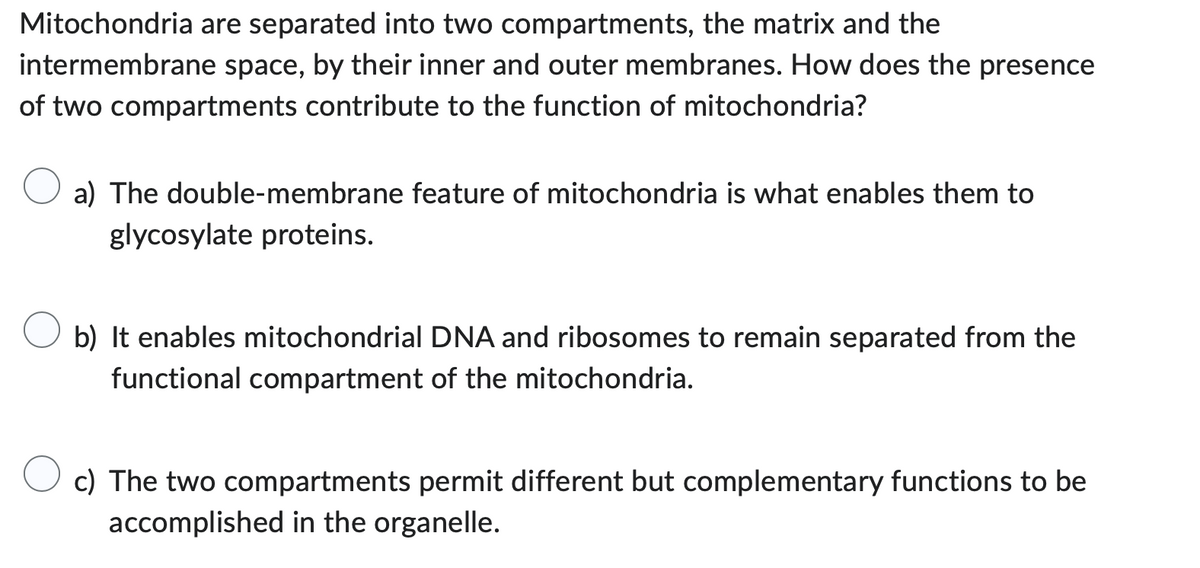Researchers tried to explain how vesicular transport occurs in cells by attempting to assemble the transport components. They set up microtubular tracks along which vesicles could be transported, and they added vesicles and ATP (because they knew the transport process requires energy). Yet, when they put everything together, there was no movement or transport of vesicles. What were they missing? a) motor proteins b) an axon c) contractile microfilaments d) endoplasmic reticulum
Researchers tried to explain how vesicular transport occurs in cells by attempting to assemble the transport components. They set up microtubular tracks along which vesicles could be transported, and they added vesicles and ATP (because they knew the transport process requires energy). Yet, when they put everything together, there was no movement or transport of vesicles. What were they missing? a) motor proteins b) an axon c) contractile microfilaments d) endoplasmic reticulum
Chemistry for Today: General, Organic, and Biochemistry
9th Edition
ISBN:9781305960060
Author:Spencer L. Seager, Michael R. Slabaugh, Maren S. Hansen
Publisher:Spencer L. Seager, Michael R. Slabaugh, Maren S. Hansen
Chapter25: Body Fluids
Section: Chapter Questions
Problem 25.12E
Related questions
Question
24,25

Transcribed Image Text:Researchers tried to explain how vesicular transport occurs in cells by attempting to
assemble the transport components. They set up microtubular tracks along which
vesicles could be transported, and they added vesicles and ATP (because they knew
the transport process requires energy). Yet, when they put everything together, there
was no movement or transport of vesicles. What were they missing?
a) motor proteins
b) an axon
c) contractile microfilaments
d) endoplasmic reticulum

Transcribed Image Text:Mitochondria are separated into two compartments, the matrix and the
intermembrane space, by their inner and outer membranes. How does the presence
of two compartments contribute to the function of mitochondria?
a) The double-membrane feature of mitochondria is what enables them to
glycosylate proteins.
b) It enables mitochondrial DNA and ribosomes to remain separated from the
functional compartment of the mitochondria.
c) The two compartments permit different but complementary functions to be
accomplished in the organelle.
Expert Solution
This question has been solved!
Explore an expertly crafted, step-by-step solution for a thorough understanding of key concepts.
This is a popular solution!
Trending now
This is a popular solution!
Step by step
Solved in 3 steps

Knowledge Booster
Learn more about
Need a deep-dive on the concept behind this application? Look no further. Learn more about this topic, chemistry and related others by exploring similar questions and additional content below.Recommended textbooks for you

Chemistry for Today: General, Organic, and Bioche…
Chemistry
ISBN:
9781305960060
Author:
Spencer L. Seager, Michael R. Slabaugh, Maren S. Hansen
Publisher:
Cengage Learning

Introduction to General, Organic and Biochemistry
Chemistry
ISBN:
9781285869759
Author:
Frederick A. Bettelheim, William H. Brown, Mary K. Campbell, Shawn O. Farrell, Omar Torres
Publisher:
Cengage Learning

Chemistry In Focus
Chemistry
ISBN:
9781305084476
Author:
Tro, Nivaldo J., Neu, Don.
Publisher:
Cengage Learning

Chemistry for Today: General, Organic, and Bioche…
Chemistry
ISBN:
9781305960060
Author:
Spencer L. Seager, Michael R. Slabaugh, Maren S. Hansen
Publisher:
Cengage Learning

Introduction to General, Organic and Biochemistry
Chemistry
ISBN:
9781285869759
Author:
Frederick A. Bettelheim, William H. Brown, Mary K. Campbell, Shawn O. Farrell, Omar Torres
Publisher:
Cengage Learning

Chemistry In Focus
Chemistry
ISBN:
9781305084476
Author:
Tro, Nivaldo J., Neu, Don.
Publisher:
Cengage Learning